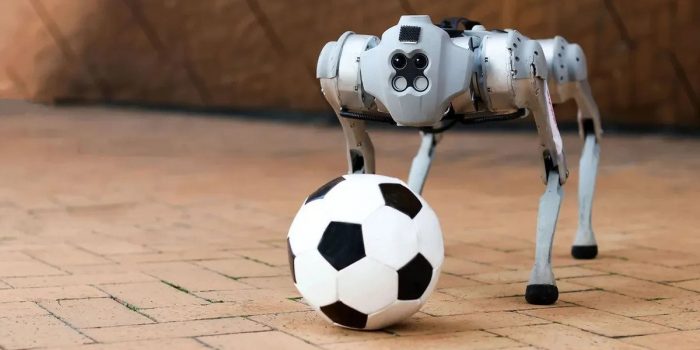Researchers at MIT’s Computer Science and Artificial Intelligence Laboratory (CSAIL) and Improbable Artificial Intelligence Lab have created a new quadruped robot named “DribbleBot.” And while the robot is designed to compete in soccer events such as RobotCup, its purpose is not limited to sports.
The team behind “DribbleBot” claims that the four-legged robot can handle various surfaces, including gravel, grass, sand, snow, and pavement, and can even pick itself up if it falls using a combination of onboarding computing and sensing.
MIT boasts that the robot moves with the same finesse as a human being (if humans had four legs), thanks to advanced technologies such as machine learning, onboard sensors, actuators, cameras, and computing power.
To master its dribbling skills, “DribbleBot” undergoes extensive practice sessions, just like a human soccer player. However, instead of relying on physical training, the robot is trained using computer simulations.
Initially, “DribbleBot” does not understand how to dribble the ball. Instead, it receives positive reinforcement when it succeeds and negative reinforcement when it fails. This method enables the robot to determine the order in which its legs should exert forces, eventually leading to successful dribbling.
“One aspect of this reinforcement learning approach is that we must design a good reward to facilitate the robot learning a successful dribbling behavior,” says MIT Ph.D. student Gabe Margolis, who co-led the work with Yandong Ji, research assistant in the Improbable AI Lab. “Once we’ve designed that reward, then it’s practice time for the robot: In real-time, it’s a couple of days, and in the simulator, hundreds of days. Over time it learns to get better and better at manipulating the soccer ball to match the desired velocity,” he added.
Kicking a football poses a unique set of challenges for a robot. Unlike a human, a robot must consider how the ball’s friction and drag interact with the ground, which is different from how its legs interact with the terrain. Therefore, the robot must simultaneously process its own movements and the ball’s trajectory.
“DribbleBot” improvements aren’t just for fun and games; they could also have some real-life benefits for society.
“If you look around today, most robots are wheeled. But imagine that there’s a disaster scenario, flooding, or an earthquake. We want robots to aid humans in the search-and-rescue process,” Pulkit Agrawal, a CSAIL principal investigator and director of Improbable AI Lab, said. “Our goal in developing algorithms for legged robots is to provide autonomy in challenging and complex terrains that are currently beyond the reach of robotic systems,” he added.


